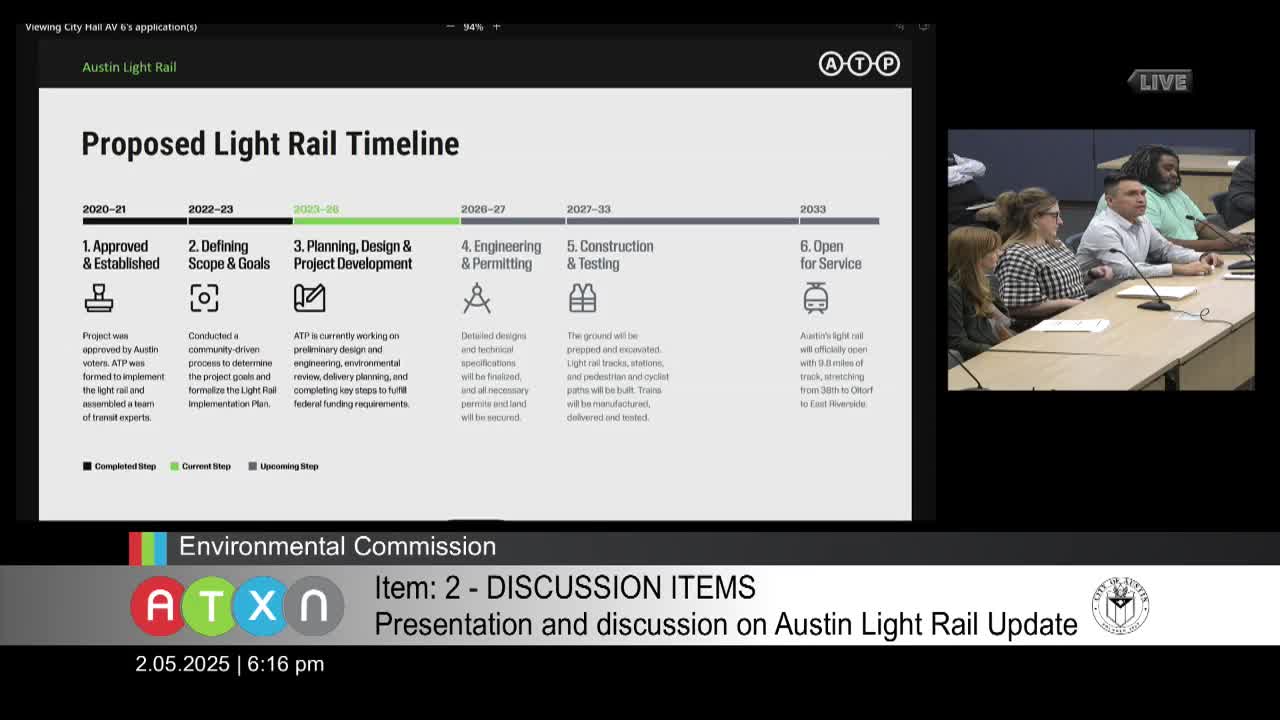Austin partners with federal government to advance light rail project development
February 05, 2025 | Austin, Travis County, Texas
This article was created by AI summarizing key points discussed. AI makes mistakes, so for full details and context, please refer to the video of the full meeting. Please report any errors so we can fix them. Report an error »

In a recent meeting of the Austin Environmental Commission, officials provided an update on the ongoing federal process for the city's light rail project. The discussion highlighted the completion of a draft environmental impact statement (EIS), a crucial step in assessing the potential effects of the light rail on the environment and the community.
The EIS is a comprehensive document that evaluates various environmental factors related to the light rail project. It includes a summary of current conditions, potential impacts, and proposed mitigation measures. The document was released to the public on January 10, with a comment period extending through March 11, allowing community members to provide input. This 60-day period exceeds the minimum requirements set by the National Environmental Policy Act, reflecting the city's commitment to transparency and community engagement.
During the meeting, officials emphasized the importance of collaboration with local partners, including the City of Austin and CapMetro, in developing the EIS. They also noted that the document, while lengthy, is accompanied by an executive summary designed to make the findings more accessible to the public. The full EIS spans several hundred pages, with additional technical reports available for those seeking more detailed information.
Looking ahead, the city plans to bring a contractor on board this year to advance the design and construction phases of the project, with construction anticipated to begin in 2027 and operations expected to start in February 2033. This timeline underscores the city's proactive approach to enhancing public transportation and addressing growing mobility needs.
The meeting served as a platform for officials to outline the project's progress and the importance of community involvement in shaping the future of Austin's transportation infrastructure. As the comment period continues, stakeholders are encouraged to engage with the process, ensuring that diverse perspectives are considered in the development of the light rail system.
The EIS is a comprehensive document that evaluates various environmental factors related to the light rail project. It includes a summary of current conditions, potential impacts, and proposed mitigation measures. The document was released to the public on January 10, with a comment period extending through March 11, allowing community members to provide input. This 60-day period exceeds the minimum requirements set by the National Environmental Policy Act, reflecting the city's commitment to transparency and community engagement.
During the meeting, officials emphasized the importance of collaboration with local partners, including the City of Austin and CapMetro, in developing the EIS. They also noted that the document, while lengthy, is accompanied by an executive summary designed to make the findings more accessible to the public. The full EIS spans several hundred pages, with additional technical reports available for those seeking more detailed information.
Looking ahead, the city plans to bring a contractor on board this year to advance the design and construction phases of the project, with construction anticipated to begin in 2027 and operations expected to start in February 2033. This timeline underscores the city's proactive approach to enhancing public transportation and addressing growing mobility needs.
The meeting served as a platform for officials to outline the project's progress and the importance of community involvement in shaping the future of Austin's transportation infrastructure. As the comment period continues, stakeholders are encouraged to engage with the process, ensuring that diverse perspectives are considered in the development of the light rail system.
View full meeting
This article is based on a recent meeting—watch the full video and explore the complete transcript for deeper insights into the discussion.
View full meeting
